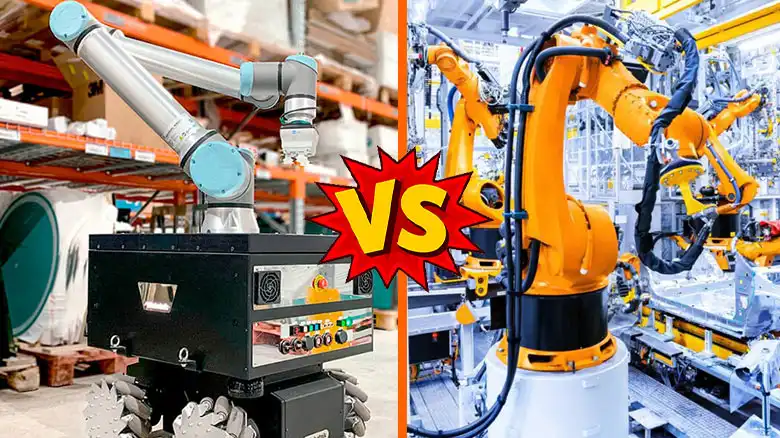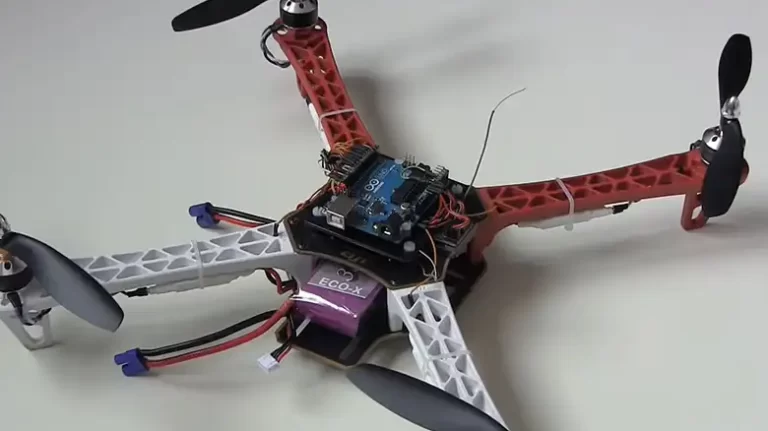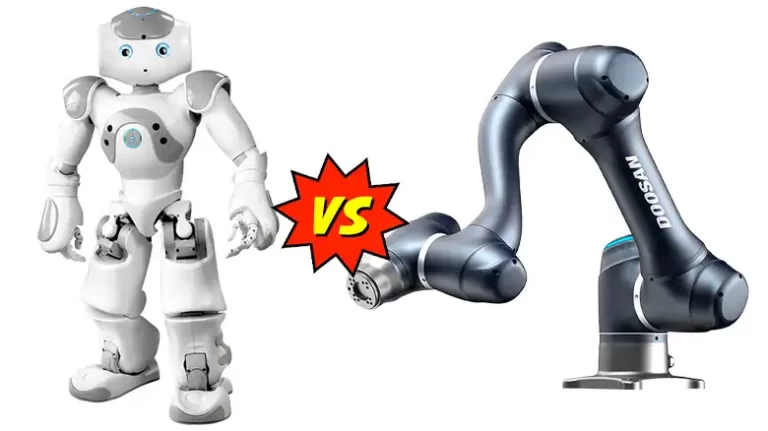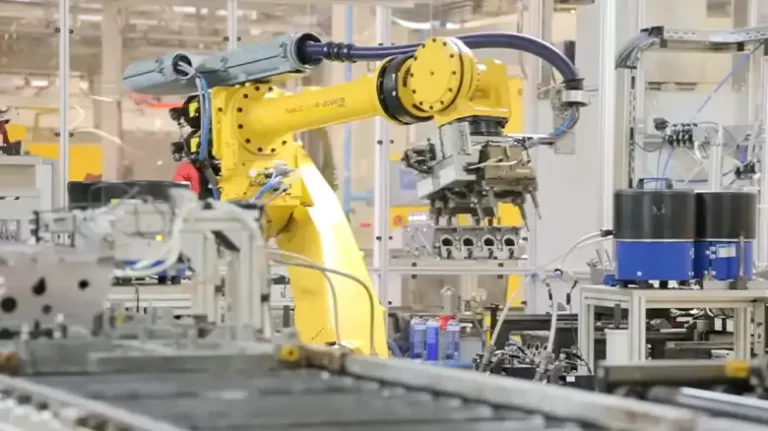Cabot’s vs. Industrial Robots: What Are The Differences?
Collaborative robots, commonly known as cobots, are a type of robot designed to work alongside humans, assisting in various tasks while ensuring safety through built-in features like force-sensing technology and collision avoidance. Industrial robots, on the other hand, are autonomous machines employed to automate specific tasks in manufacturing and industrial settings.
So, it’s natural that there will be a lot of differences between these two, which I am gonna discuss in today’s blog post. So, read on.

Cobots vs. Industrial Robots
Let;s start off with a simple difference chart between the two:
| Aspect | Collaborative Robots (Cobots) | Industrial Robots |
| Purpose | Assist, work alongside humans | Automate tasks autonomously |
| Safety Features | Built-in safety systems | Safety through separation |
| Design | Compact and lightweight | Heavy and sturdy |
| Programming | User-friendly interfaces | Complex programming |
| Mobility | Easily movable and flexible | Stationary or fixed |
| Payload Capacity | Lower | Higher |
| Cost | Lower initial cost | Higher initial cost |
| Installation | Quick and easy | Lengthy and complex |
| Applications | Versatile, diverse tasks | Repetitive, specialized |
| Interaction with Humans | Safe, close collaboration | Distant, limited interaction |
| Scalability | Easy to scale up | Limited scalability |
Differences Explained
Purpose:
Cobots: Collaborative robots are designed to work alongside human operators. They are intended to assist in tasks that require a combination of human skills and automation. These robots are built with the aim of enhancing productivity while ensuring worker safety.
Industrial Robots: Industrial robots, on the other hand, are primarily designed for autonomous operation. They replace or augment human labor in repetitive, dangerous, or highly specialized tasks, without the need for human intervention.
Safety Features:
Cobots: Cobots are equipped with built-in safety features such as force-sensing technology, collision avoidance, and the ability to slow down or stop when they encounter an obstruction. These features make them safe for close collaboration with humans.
Industrial Robots: Safety in industrial robot environments is maintained through physical separation from human workers. Safety cages or restricted access areas are commonly used to prevent accidental contact.
Design:
Cobots: Collaborative robots are designed to be compact, lightweight, and user-friendly. They often have rounded edges and soft exteriors to minimize the risk of injury in case of contact with humans.
Industrial Robots: Industrial robots tend to be heavier and sturdier in design, with a focus on durability and precision rather than human interaction safety.
Programming:
Cobots: Cobots are typically programmed using intuitive interfaces that allow non-experts to teach them tasks. Programming can be done through a simple touchscreen or by manually guiding the robot through the desired motions.
Industrial Robots: Industrial robots often require highly specialized programming by trained technicians, making them less accessible to non-experts.
Mobility:
Cobots: Collaborative robots are designed to be mobile and flexible. They can be easily moved from one task to another, making them adaptable to changing production needs.
Industrial Robots: Industrial robots are usually stationary or fixed to perform specific tasks, requiring significant changes to the production line if reconfigured.
Payload Capacity:
Cobots: Cobots generally have a lower payload capacity compared to industrial robots. They are better suited for lighter tasks and materials handling.
Industrial Robots: Industrial robots are capable of handling heavier payloads, making them suitable for tasks involving large and heavy objects.
Cost:
Cobots: Collaborative robots typically have a lower initial cost compared to industrial robots. Their cost-effectiveness is partially due to ease of use and flexibility.
Industrial Robots: Industrial robots come with a higher initial investment cost, attributed to their complex programming and higher payload capacities.
Installation:
Cobots: Installing cobots is relatively quick and easy, requiring minimal downtime and disruption to existing processes.
Industrial Robots: Installing industrial robots can be a lengthy and complex process, often involving the modification of existing infrastructure and workflows.
Applications:
Cobots: Collaborative robots have versatile applications and are suitable for a wide range of tasks, from assembly and quality control to logistics and healthcare.
Industrial Robots: Industrial robots are typically employed in repetitive, specialized tasks, such as welding, painting, and heavy machinery operations.
Interaction with Humans:
Cobots: Cobots are designed for safe and close collaboration with humans. They can work side by side with human operators without posing a significant safety risk.
Industrial Robots: Interaction with industrial robots is limited and usually occurs at a distance, or within safety cages, minimizing direct contact with human workers.
Scalability:
Cobots: Cobots are relatively easy to scale up within a manufacturing or industrial environment. Adding more cobots to an existing setup is straightforward.
Industrial Robots: Industrial robots often have limited scalability as adding or reconfiguring them may require significant investments in infrastructure and programming.
What is the main advantage of using cobots over industrial robots?
The main advantage of using cobots is their ability to work alongside human operators safely, making them ideal for tasks that require human-robot collaboration. They are more flexible, easily programmable, and have a lower initial cost.
In what industries are cobots commonly used?
Cobots are commonly used in industries such as automotive manufacturing, electronics, healthcare, and food production, where tasks like assembly, inspection, and materials handling can benefit from human-robot collaboration.
Do cobots completely eliminate the need for human labor in manufacturing?
No, cobots are designed to augment human labor rather than replace it entirely. They excel at tasks that require a combination of human dexterity, judgment, and automation.
What are some typical applications for industrial robots?
Industrial robots are typically used in applications like welding, painting, material handling, and heavy machinery operation, where precision, repeatability, and high payload capacities are essential.
Are safety measures needed when working with industrial robots?
Yes, safety measures such as safety cages, restricted access areas, and emergency stop systems are essential when working with industrial robots to prevent accidents and protect human workers.
How can a company decide between using cobots or industrial robots in their production processes?
The choice between cobots and industrial robots depends on the specific needs of the company, the nature of the tasks, and the level of human-robot collaboration required. Cobots are suitable for flexible, collaborative tasks, while industrial robots excel in repetitive, high-precision applications.
End Notes
Cobots and industrial robots are two distinct categories of robots with different designs, applications, and interaction capabilities. Cobots are designed for close collaboration with humans and are ideal for flexible, diverse tasks, while industrial robots are best suited for repetitive, specialized tasks. Understanding these differences is crucial for businesses looking to implement automation solutions in their production processes, as it allows them to make informed decisions based on their unique needs and goals. Both cobots and industrial robots play essential roles in the ever-evolving landscape of manufacturing and industry, contributing to increased efficiency, quality, and safety.





